Roku 4 review: 4K is nice, but otherwise it's not a huge upgrade

It's no surprise that the Roku 4 is a solid set-top box -- Roku has been making them for a while now, after all. It's also not surprising that the new Roku's search is smart, that the interface is fast and fluid or that there's a bountiful selection of apps. In fact, there isn't much that's truly surprising, or revolutionary, about the Roku 4 ($130). It's a solid, if somewhat unexciting upgrade, especially after the Roku 3 from earlier this year, which brought voice search into the mix. Just like the new Fire TV, Roku is betting that the addition of 4K ultra-high-definition video (UHD) is exciting enough on its own. And, while it's certainly noteworthy, it's also something that will only appeal to just a handful of consumers. Basically, if you're happy with your Roku 3, or any other equivalent set-top box, you won't need to rush out and grab this one. Although when you do finally go 4K, it's a worthy choice.
Hardware
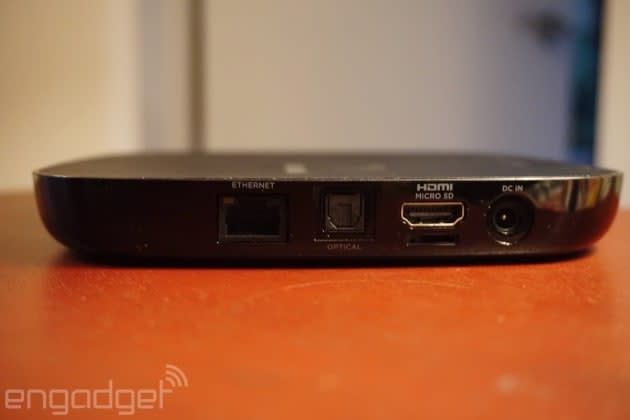
While Roku's last few devices looked like high-tech hockey pucks, the Roku 4 is flatter and significantly wider. Still, the same basic design elements are there: black plastic, a quirky Roku cloth tag (honestly, I'm surprised more tech companies haven't copied this) and a big "4" logo up top. I was pretty surprised when I first opened the Roku 4 -- it's not just wide; it's wider than most other streaming gadgets. Don't expect it to squeeze into the same tiny nooks as past Rokus. On the back, there's an optical audio port, microSD slot and Ethernet jack, alongside the HDMI connector. One particularly useful addition is a button on the top of the box that locates the remote -- a simple, yet ingenious feature.
Speaking of the remote, it's exactly the same as the refreshed Roku 3's controller. It has gamepad-like directional arrows, a voice search button (more on that later) and your typical video controls, as well as buttons on the bottom for Netflix, Amazon, Rdio and Sling. The latter are useful if you're actually subscribing to those services, but for many people at least two of them will likely just be a waste of space. And yes, Roku is still keeping the headphone jack (and bundled earbuds) that's won it so many fans.
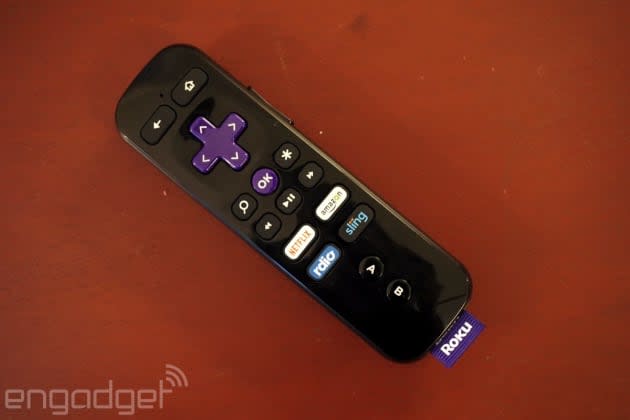
Under the hood, the Roku 4 is powered by a newer quad-core processor. And, for the first time, it also sports a tiny fan that you can actually hear while it's running. It's not excessively loud, or anything, but it's noticeable when you're up close. You can thank the extra hardware demands of 4K video for that.
Software
Roku OS 7 sits at the heart of the Roku 4, which brings more advanced search capabilities, as well as a feed (and accompanying notifications) to the home screen. There's also a new feature that lets you connect to WiFi networks that require additional login information, like hotels and dorm rooms, through your computer, smartphone or tablet. And if you haven't looked at the Roku OS lately, it also lets you follow films and actors, which sends information directly to your feed. That's yet another feature that was added earlier this year.
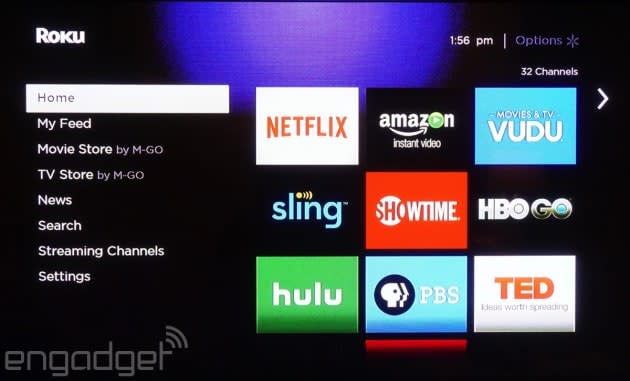
Again, if you've seen Roku's offerings before, OS 7 isn't going to surprise you. There's the same purple-and-black palette, a ho-hum list-style interface and lots and lots of menus. It's functional, but Roku's design sensibility clearly needs some upgrading, especially when Apple and Amazon are stepping it up for their own devices. And considering that Samsung and LG have also managed to design some luscious TV interfaces, Roku basically has no excuse for being dull.
To coincide with the launch of the Roku 4 and OS 7, the company also refreshed its mobile app with a more modern design. The app does everything it did before -- you can search for content, control your Roku and shop the channel store -- but it also adds the ability to view your feed and create 4K screensavers from your own photos. Eventually, you'll also be able to add movies, actors and directors to your feed when away from home. The biggest benefit of the app: It no longer looks like it was made by an intern years ago. I'm hoping some of the design upgrades someday make their way over to Roku's set-top OS as well.
In use
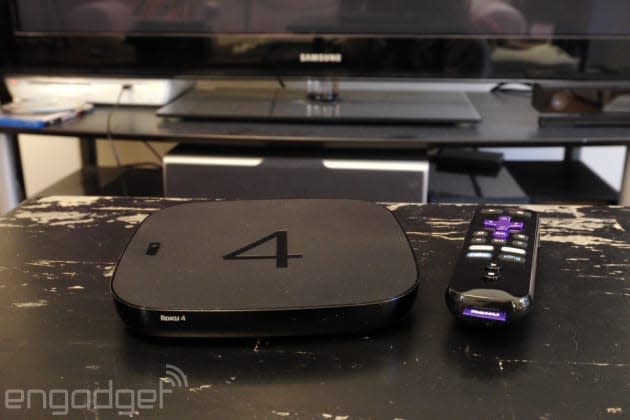
Setting up the Roku 4 was a breeze, especially since all of my existing apps carried over as soon as I logged into my Roku account. It may just be my imagination, but navigating around its interface feels slightly faster than the first-gen Roku 3 in my bedroom, although it's certainly not a big enough difference to upgrade.
Voice search is also pretty useful: Hit the search button on the remote; say a title or actor's name; and Roku delivers results. If a particular film or show is on multiple services, it'll actually randomize the order of results so it doesn't appear to be playing favorites. I also appreciated the ability to follow specific actors and titles, as it made finding when they were added to new services significantly easier.
While the search was generally fast and accurate, there were definitely instances where it wouldn't locate things I knew were streaming on Netflix. And as with most voice search offerings, you can forget about trying to dictate weird or complex movie names. The Roku 4 couldn't even make sense of Darren Aronofsky's Pi. Still, voice search beats poking around all of the streaming titles by hand. I just hope that Roku continues to refine it.
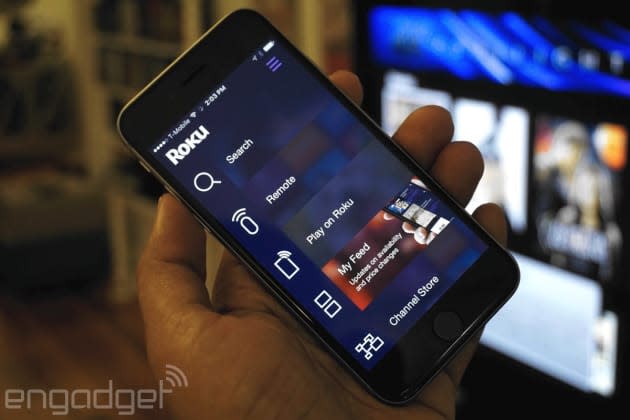
Streaming 1080p video on the Roku 4 didn't feel much more different compared to its predecessor. At this point though, handling that sort of content is pretty much a cakewalk. When it comes to higher-resolution UHD streams, on the other hand, the Roku 4 takes several seconds to load up a video on my 802.11ac network. Skipping ahead also required a few seconds of buffering -- remember, 4K files are really big! I noticed slightly better video quality on a few 4K monitors, but to be honest, you won't really see the benefits of 4K unless you have a very large TV, and/or sit way too close.
Roku also went the extra mile and made ultra-high-definition content pretty easy to find. There's a selection of apps with 4K content, including Netflix, YouTube and Amazon Video, right off of the channel store. And there's also a spotlight channel for 4K content, which shows the latest films and TV available in the higher-resolution format from multiple providers. The Roku 4 can even handle your own personal library of UHD video, either via the Roku Media Player app or Plex.
Overall, the Roku 4 builds on the company's streaming prowess in all of the right ways. It offers the most comprehensive selection of 4K streaming content out there, and it's organized well enough that even mainstream consumers shouldn't have any trouble finding things to watch in the newer format. The big downside, unfortunately, is that it doesn't support HDR (high-dynamic range) video yet, since that standard hasn't been fully finalized. Amazon is already hyping up HDR, because it offers visual changes you can actually see, like better contrast and shadows, compared to the mild sharpness bump of 4K.
The competition
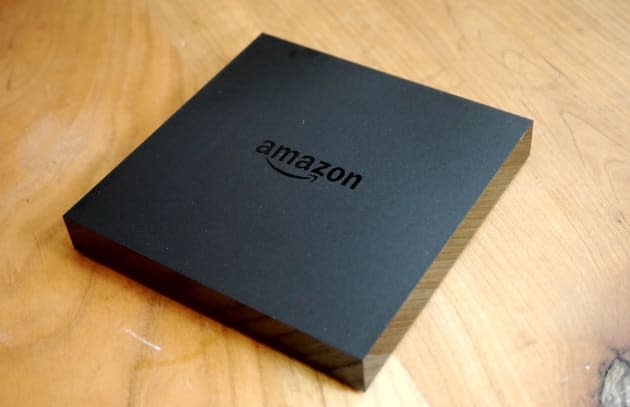
When it comes to UHD, the Roku 4's main competitor is Amazon's new 4K Fire TV. Amazon has the price advantage, as its player is $100, compared to the Roku 4 at $130. Roku still has a much wider selection of apps, and it's also far more unbiased when it comes to search results. The Fire TV will always be a not-so-subtle Trojan horse for Amazon's content library. If you've got a UHD TV, there's also a good chance you've already got access to Netflix 4K content and rental services.
If you don't plan on getting a 4K set anytime soon, then it's also worth considering the new Apple TV, which also has a pretty decent voice search offering and integrates better with iOS devices. Apple is only beginning to build up an app store, but the options there right now are on the whole better designed than Roku's apps. The Apple TV is more expensive though, at $149, and it doesn't support 4K content yet. There's also the revamped Roku 3 ($100) from earlier this year to consider, which also maxes out at 1080p, but includes voice search and all of the upgrades from Roku OS 7.
Wrap-up
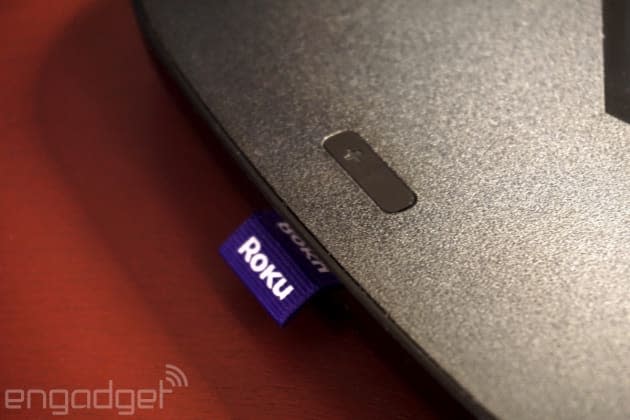
The Roku 4 is exactly what we'd expect from the company: a solid media box that plays well with multiple video services. But it's really only a worthwhile upgrade if you're going all-in with 4K. If you're happy with your current 1080p TV set and media box, then sit tight. You could argue that it's worth snapping up the Roku 4 to future-proof your setup, but by next year, newer standards like HDR will get ironed out and supported across all 4K devices and TV sets.














